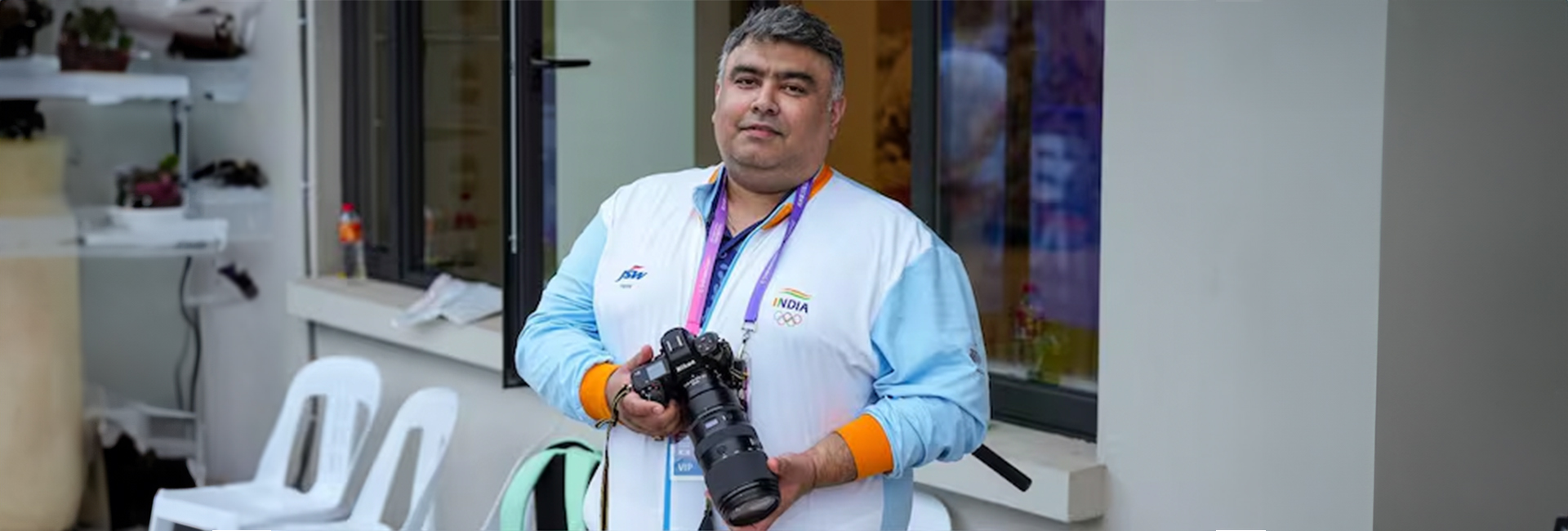(August 10, 2024) It was at the Stade de France that Asian Games champion Avinash Sable lined up with his opponents for the men’s 3000m steeplechase final at the Paris Olympics 2024. Sprinting in his orange shoes, he made a quick start and led the pack in the opening lap but soon fell behind and ended up finishing eleventh in a sport that’s mostly dominated by East African athletes. Though he failed to win a medal at the Paris Olympics, Indian athletes achieved a series of firsts at the sporting event. Among these achievements was Sable becoming the first Indian to qualify for the men’s 3000m steeplechase final, finishing fifth in the qualification round with a timing of 8:15.43.

Avinash Sable at Paris Olympics 2024
The Indian athlete, also a national record-holder in men’s 5000m, is a man of determination and hard work. Coming from Beed district, an area known for its landless workers and migrant labourers, Avinash faced a harsh reality that fuelled his drive for success. Watching his parents constantly move for work instilled in him a relentless work ethic and a passion to do whatever it takes to achieve his goals. “For me, the background of the athlete is very important. Those who come from humble families, from the villages have faced the worst situations in life, those things made them hardened and battle-ready. They are not afraid of adversity and want to work hard. Sable was special and different from others. He has a will of steel and he can come back from any worse scenario” his former coach Amrish Kumar said in an interview.
Sable, who set a national record with his best timing of 8:09.94 during this year’s Diamond League, never initially intended to become an athlete. “When I was a child, I had never thought I would become an athlete and win medals for the country. It’s destiny,” the Global Indian said.
Adversity shaped his ability to overcome any obstacle
Born into a farmer’s family in 1994 in Mandwa village, Beed district, Maharashtra, Sable grew up with modest means. His parents owned a small piece of land and worked as daily wage laborers in brick kilns. With his school nearly six kilometers away, Sable often ran to make it on time, while also helping his parents part-time at the kilns. Recognizing his potential, his schoolteachers encouraged him to participate in a local marathon at the age of nine. He won first place and a cash prize of ₹100. This victory boosted his confidence, and the muddy roads of his village soon became his training ground.
View this post on Instagram
While continuing to train and run marathons, Sable began working at construction sites after finishing Class 10 to help his family earn extra income. Despite enrolling in a local college, his struggles persisted. He had to run eight kilometers daily to reach college, where his talent was once again recognized by a teacher who played a pivotal role in broadening his horizons by accompanying him to collegiate-level track and field competitions. Always eager to join the Indian Army, Sable was recruited into the 5 Mahar regiment at the age of 18. In his early years of service, Avinash endured two extreme weather conditions—first, in the freezing cold of Siachen, the world’s highest battlefield, and later in the scorching 50-degree Celsius heat of Rajasthan. These experiences toughened him, preparing him to face any challenge that came his way.
Discovering his passion for Steeplechase
This determination led him to participate in a cross-country race within his regiment, and he soon began competing in larger events, eventually securing fifth place at the National Cross-Country Championship. It was there that he met his coach, Amrish Kumar, an Indian Army coach who mentors long-distance athletes. Kumar recognized Sable’s potential and pushed him to improve further. In 2017, at Kumar’s suggestion, Avinash switched from cross-country to the 3000m steeplechase. Within just one year of dedicated training, Sable shattered a national record that had stood for 37 years, achieving this remarkable feat in 2018.

The following year, at the Federation Cup in Patiala, Sable set a new record with a time of 8:28.94. This outstanding performance qualified him for both the 2019 Asian Athletics Championships and the 2019 World Athletics Championships, making him the first Indian male steeplechaser to qualify for the World Championships. He secured a silver medal in his international debut at the 2019 Asian Athletics Championships in Doha and went on to break his own national record twice at the World Championships. “The steeplechase is a very tactical race. So, most times, I was told it was not possible to break this record in India because no one can set that kind of pace in India. So, I had to set the pace for myself too,” Avinash said in an interview.
Racing to the finish line
In the final, Sable finished 13th with an impressive time of 8:21.37, not only surpassing the national record once more but also securing his qualification for the Tokyo 2020 Olympics. This remarkable feat made him the first Indian to qualify for the steeplechase event at the Olympics since Gulzara Singh Mann in 1952. However, the COVID-19 pandemic delayed the Olympics by a year, and just three months before the rescheduled Tokyo Olympics in 2021, Avinash tested positive, impacting his performance at the world’s biggest sporting event. Despite this setback, he managed to break his record yet again, though it was only enough to secure a seventh-place finish.
View this post on Instagram
However, Sable made a remarkable comeback at the 2022 Commonwealth Games in Birmingham, winning a silver medal in the steeplechase. This achievement made him the first athlete from outside Kenya to win a medal in the men’s 3000 meters steeplechase at the Commonwealth Games since 1994. He then reached new heights at the 2023 Asian Games, where he made history by winning India’s first-ever gold medal in the steeplechase and also earned a silver medal in the men’s 5000m.
His participation in the 3000m steeplechase final at the Paris Olympics 2024 marked a significant chapter in his illustrious career. His journey, from humble beginnings to becoming a global contender, reflects his unwavering determination and resilience. Despite the intense competition and challenges, Sable’s performance in Paris showcased his exceptional talent and grit, solidifying his place as one of India’s premier athletes.
- Follow Avinash Sable on Instagram




